Food Service Management Report: The Coach Restaurant Case Study
VerifiedAdded on 2023/01/06
|16
|5072
|53
Report
AI Summary
This report provides a comprehensive analysis of food service management, focusing on The Coach restaurant in Buckinghamshire, UK. It explores various aspects, including supply chain approaches, procurement strategies, and ethical practices. The report examines different food supply chain models, highlighting key stakeholders and the principles of effective procurement. It also assesses the application of analytical tools like SWOT analysis to support effective management strategies. Furthermore, the report discusses ethical practices within the restaurant and their impact on business success. Finally, it evaluates the current management practices and operational performance, offering recommendations for improvements and alternative management strategies, including an implementation plan. The report emphasizes the importance of quality control, value for money, and after-sales service in procurement, while also considering the use of tools like SWOT analysis to enhance organizational effectiveness.
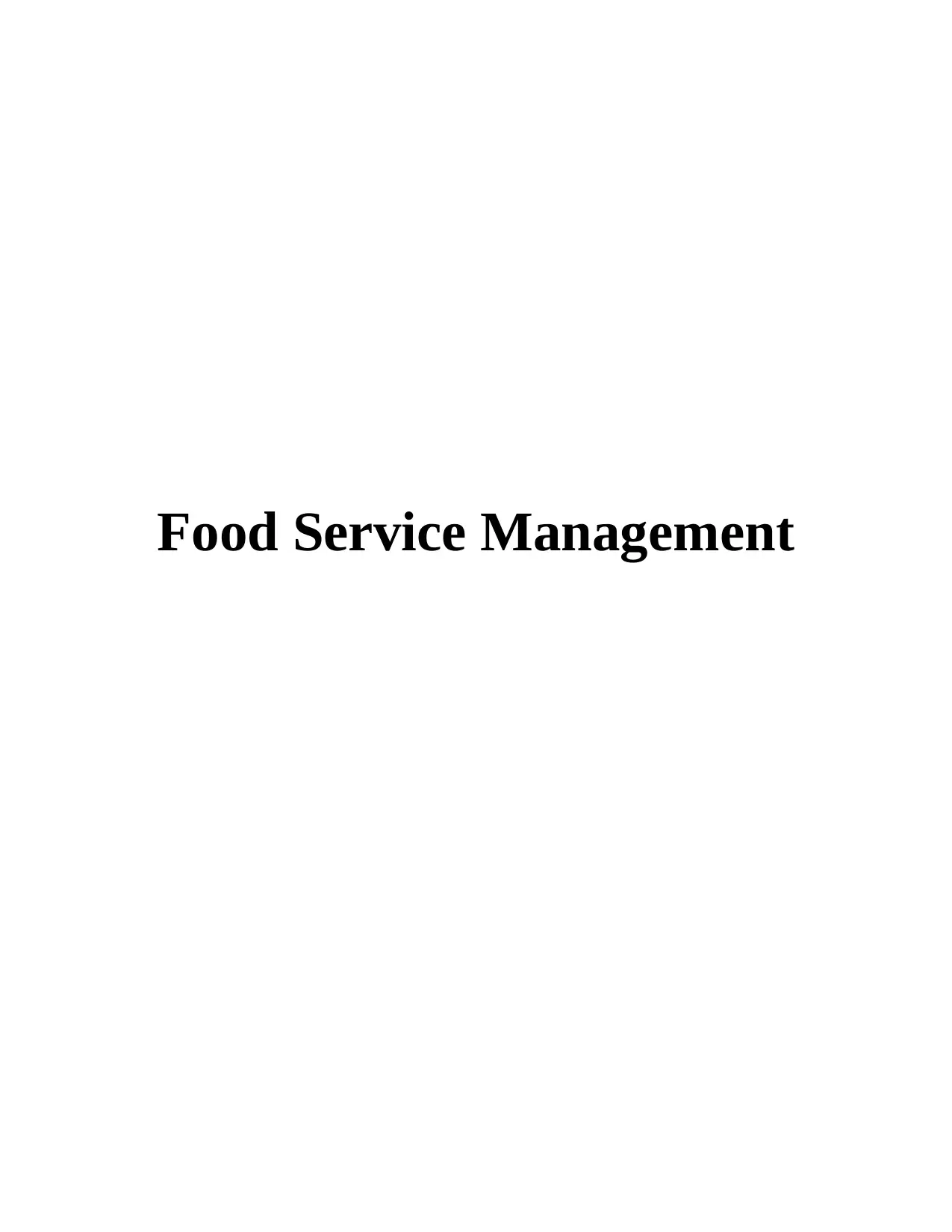
Food Service Management
Paraphrase This Document
Need a fresh take? Get an instant paraphrase of this document with our AI Paraphraser
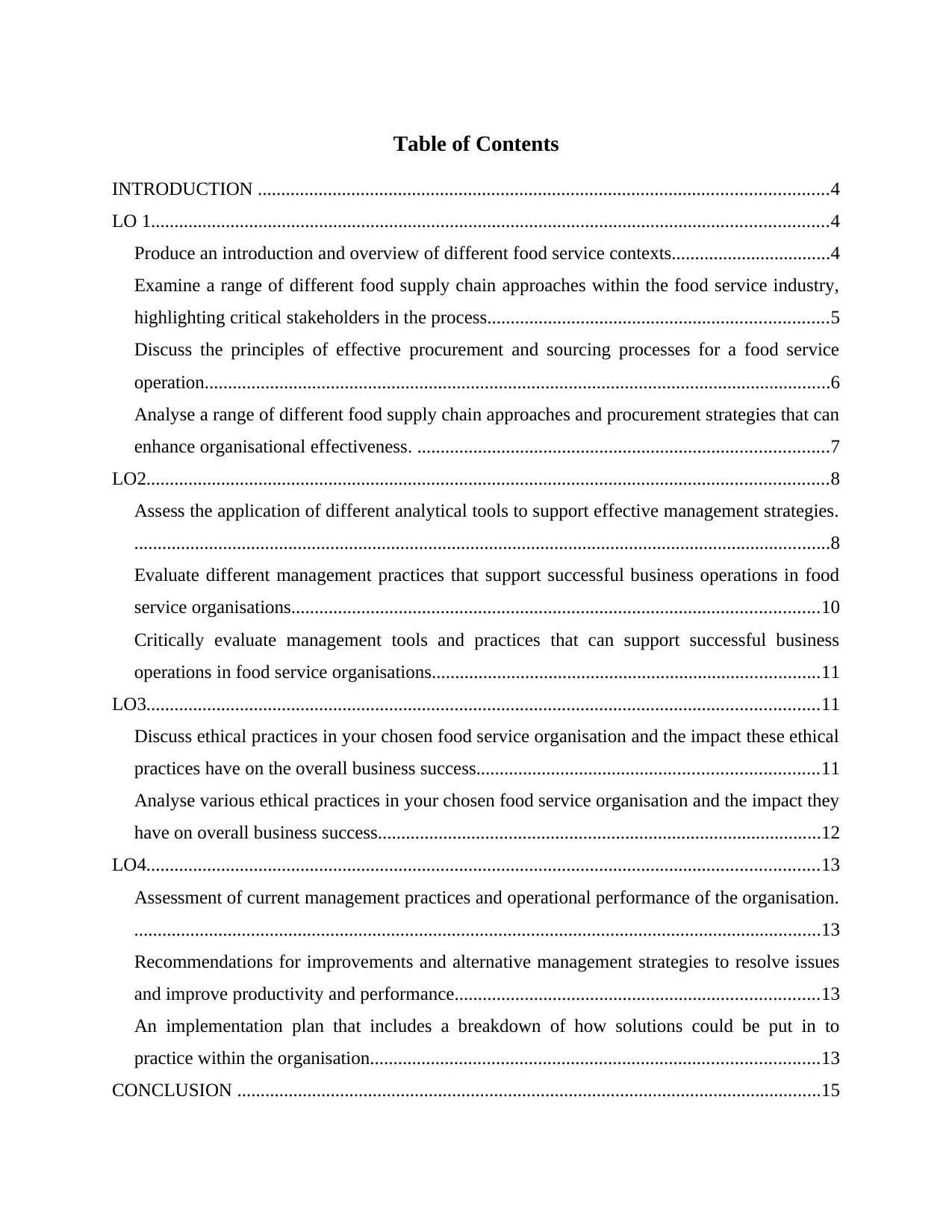
Table of Contents
INTRODUCTION ..........................................................................................................................4
LO 1.................................................................................................................................................4
Produce an introduction and overview of different food service contexts..................................4
Examine a range of different food supply chain approaches within the food service industry,
highlighting critical stakeholders in the process.........................................................................5
Discuss the principles of effective procurement and sourcing processes for a food service
operation......................................................................................................................................6
Analyse a range of different food supply chain approaches and procurement strategies that can
enhance organisational effectiveness. ........................................................................................7
LO2..................................................................................................................................................8
Assess the application of different analytical tools to support effective management strategies.
.....................................................................................................................................................8
Evaluate different management practices that support successful business operations in food
service organisations.................................................................................................................10
Critically evaluate management tools and practices that can support successful business
operations in food service organisations...................................................................................11
LO3................................................................................................................................................11
Discuss ethical practices in your chosen food service organisation and the impact these ethical
practices have on the overall business success.........................................................................11
Analyse various ethical practices in your chosen food service organisation and the impact they
have on overall business success...............................................................................................12
LO4................................................................................................................................................13
Assessment of current management practices and operational performance of the organisation.
...................................................................................................................................................13
Recommendations for improvements and alternative management strategies to resolve issues
and improve productivity and performance..............................................................................13
An implementation plan that includes a breakdown of how solutions could be put in to
practice within the organisation................................................................................................13
CONCLUSION .............................................................................................................................15
INTRODUCTION ..........................................................................................................................4
LO 1.................................................................................................................................................4
Produce an introduction and overview of different food service contexts..................................4
Examine a range of different food supply chain approaches within the food service industry,
highlighting critical stakeholders in the process.........................................................................5
Discuss the principles of effective procurement and sourcing processes for a food service
operation......................................................................................................................................6
Analyse a range of different food supply chain approaches and procurement strategies that can
enhance organisational effectiveness. ........................................................................................7
LO2..................................................................................................................................................8
Assess the application of different analytical tools to support effective management strategies.
.....................................................................................................................................................8
Evaluate different management practices that support successful business operations in food
service organisations.................................................................................................................10
Critically evaluate management tools and practices that can support successful business
operations in food service organisations...................................................................................11
LO3................................................................................................................................................11
Discuss ethical practices in your chosen food service organisation and the impact these ethical
practices have on the overall business success.........................................................................11
Analyse various ethical practices in your chosen food service organisation and the impact they
have on overall business success...............................................................................................12
LO4................................................................................................................................................13
Assessment of current management practices and operational performance of the organisation.
...................................................................................................................................................13
Recommendations for improvements and alternative management strategies to resolve issues
and improve productivity and performance..............................................................................13
An implementation plan that includes a breakdown of how solutions could be put in to
practice within the organisation................................................................................................13
CONCLUSION .............................................................................................................................15
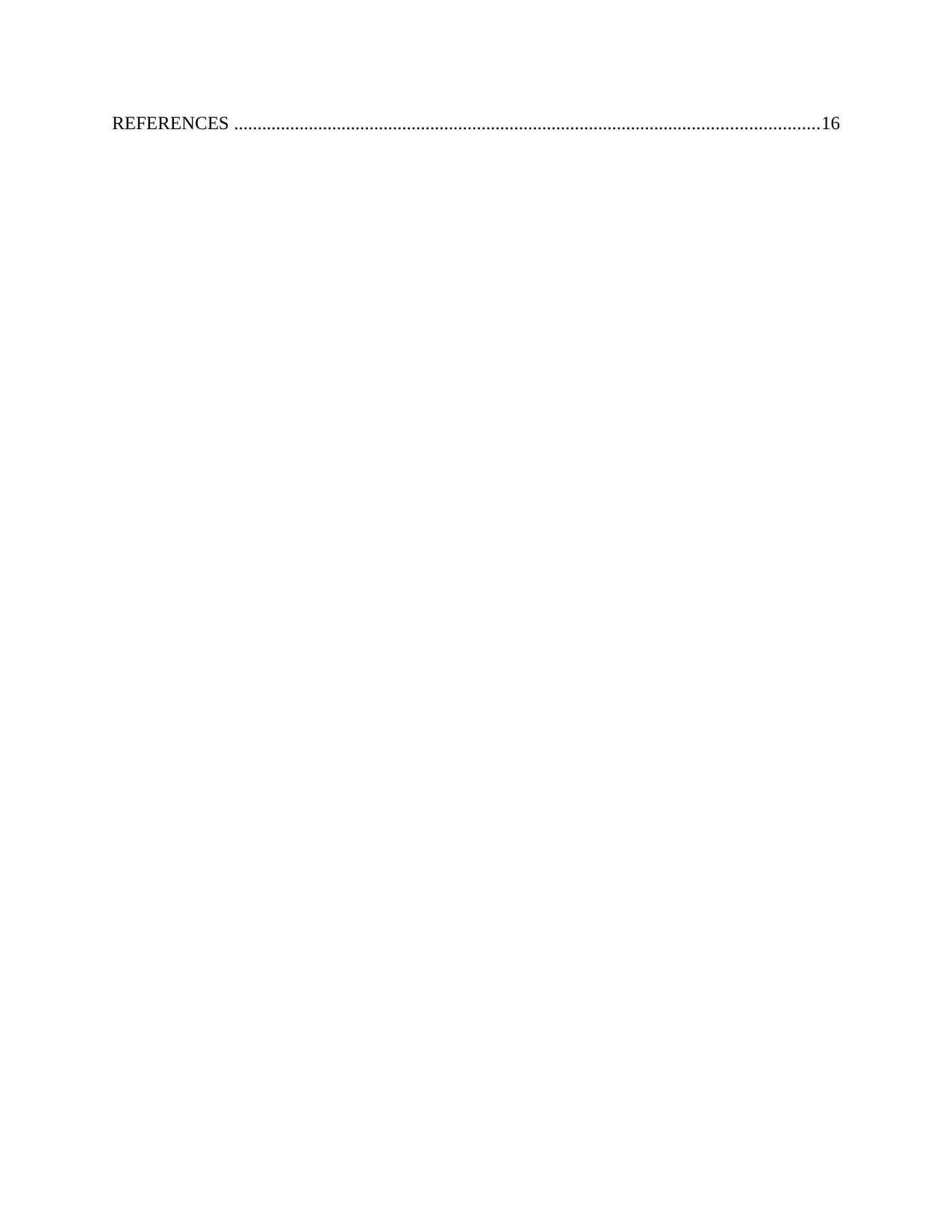
REFERENCES .............................................................................................................................16
⊘ This is a preview!⊘
Do you want full access?
Subscribe today to unlock all pages.

Trusted by 1+ million students worldwide
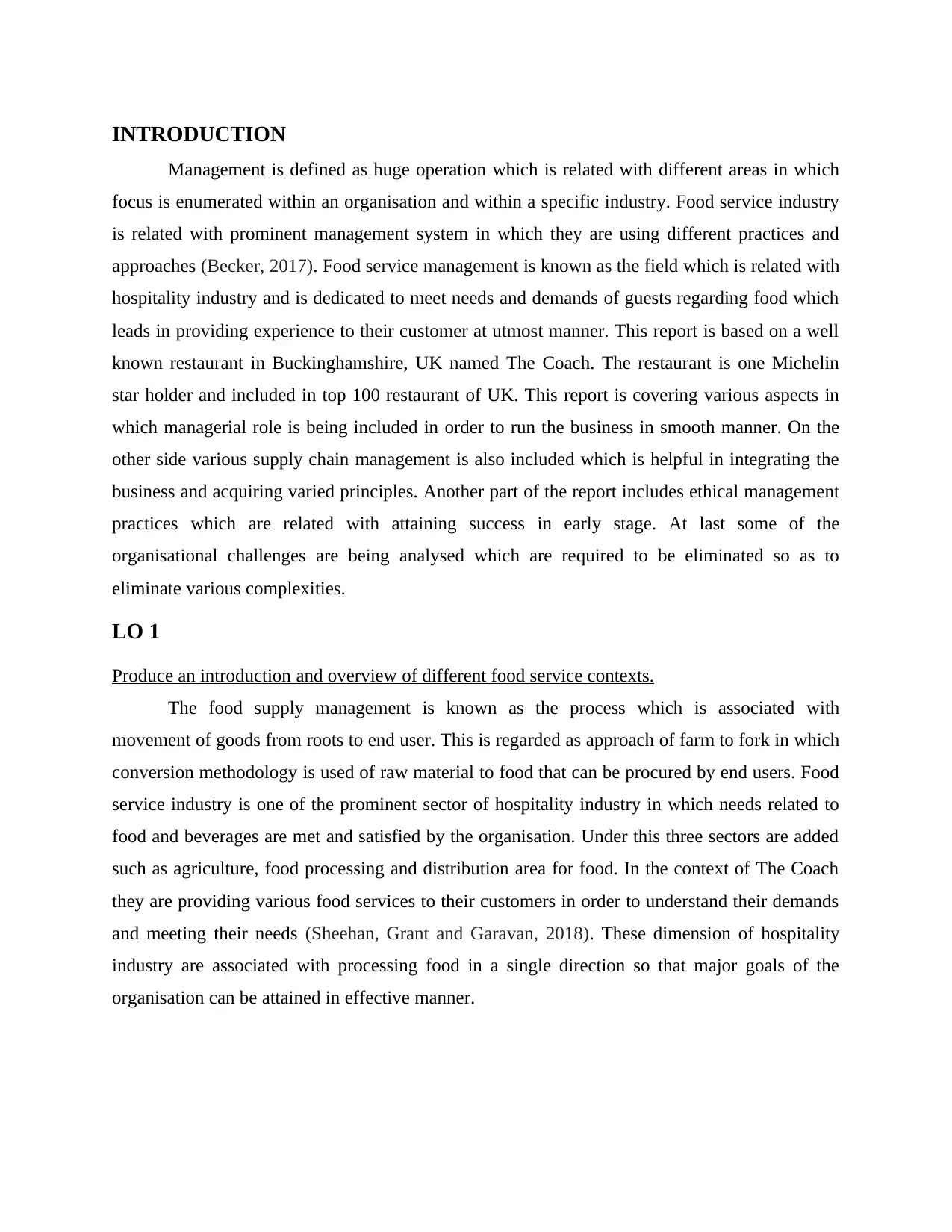
INTRODUCTION
Management is defined as huge operation which is related with different areas in which
focus is enumerated within an organisation and within a specific industry. Food service industry
is related with prominent management system in which they are using different practices and
approaches (Becker, 2017). Food service management is known as the field which is related with
hospitality industry and is dedicated to meet needs and demands of guests regarding food which
leads in providing experience to their customer at utmost manner. This report is based on a well
known restaurant in Buckinghamshire, UK named The Coach. The restaurant is one Michelin
star holder and included in top 100 restaurant of UK. This report is covering various aspects in
which managerial role is being included in order to run the business in smooth manner. On the
other side various supply chain management is also included which is helpful in integrating the
business and acquiring varied principles. Another part of the report includes ethical management
practices which are related with attaining success in early stage. At last some of the
organisational challenges are being analysed which are required to be eliminated so as to
eliminate various complexities.
LO 1
Produce an introduction and overview of different food service contexts.
The food supply management is known as the process which is associated with
movement of goods from roots to end user. This is regarded as approach of farm to fork in which
conversion methodology is used of raw material to food that can be procured by end users. Food
service industry is one of the prominent sector of hospitality industry in which needs related to
food and beverages are met and satisfied by the organisation. Under this three sectors are added
such as agriculture, food processing and distribution area for food. In the context of The Coach
they are providing various food services to their customers in order to understand their demands
and meeting their needs (Sheehan, Grant and Garavan, 2018). These dimension of hospitality
industry are associated with processing food in a single direction so that major goals of the
organisation can be attained in effective manner.
Management is defined as huge operation which is related with different areas in which
focus is enumerated within an organisation and within a specific industry. Food service industry
is related with prominent management system in which they are using different practices and
approaches (Becker, 2017). Food service management is known as the field which is related with
hospitality industry and is dedicated to meet needs and demands of guests regarding food which
leads in providing experience to their customer at utmost manner. This report is based on a well
known restaurant in Buckinghamshire, UK named The Coach. The restaurant is one Michelin
star holder and included in top 100 restaurant of UK. This report is covering various aspects in
which managerial role is being included in order to run the business in smooth manner. On the
other side various supply chain management is also included which is helpful in integrating the
business and acquiring varied principles. Another part of the report includes ethical management
practices which are related with attaining success in early stage. At last some of the
organisational challenges are being analysed which are required to be eliminated so as to
eliminate various complexities.
LO 1
Produce an introduction and overview of different food service contexts.
The food supply management is known as the process which is associated with
movement of goods from roots to end user. This is regarded as approach of farm to fork in which
conversion methodology is used of raw material to food that can be procured by end users. Food
service industry is one of the prominent sector of hospitality industry in which needs related to
food and beverages are met and satisfied by the organisation. Under this three sectors are added
such as agriculture, food processing and distribution area for food. In the context of The Coach
they are providing various food services to their customers in order to understand their demands
and meeting their needs (Sheehan, Grant and Garavan, 2018). These dimension of hospitality
industry are associated with processing food in a single direction so that major goals of the
organisation can be attained in effective manner.
Paraphrase This Document
Need a fresh take? Get an instant paraphrase of this document with our AI Paraphraser
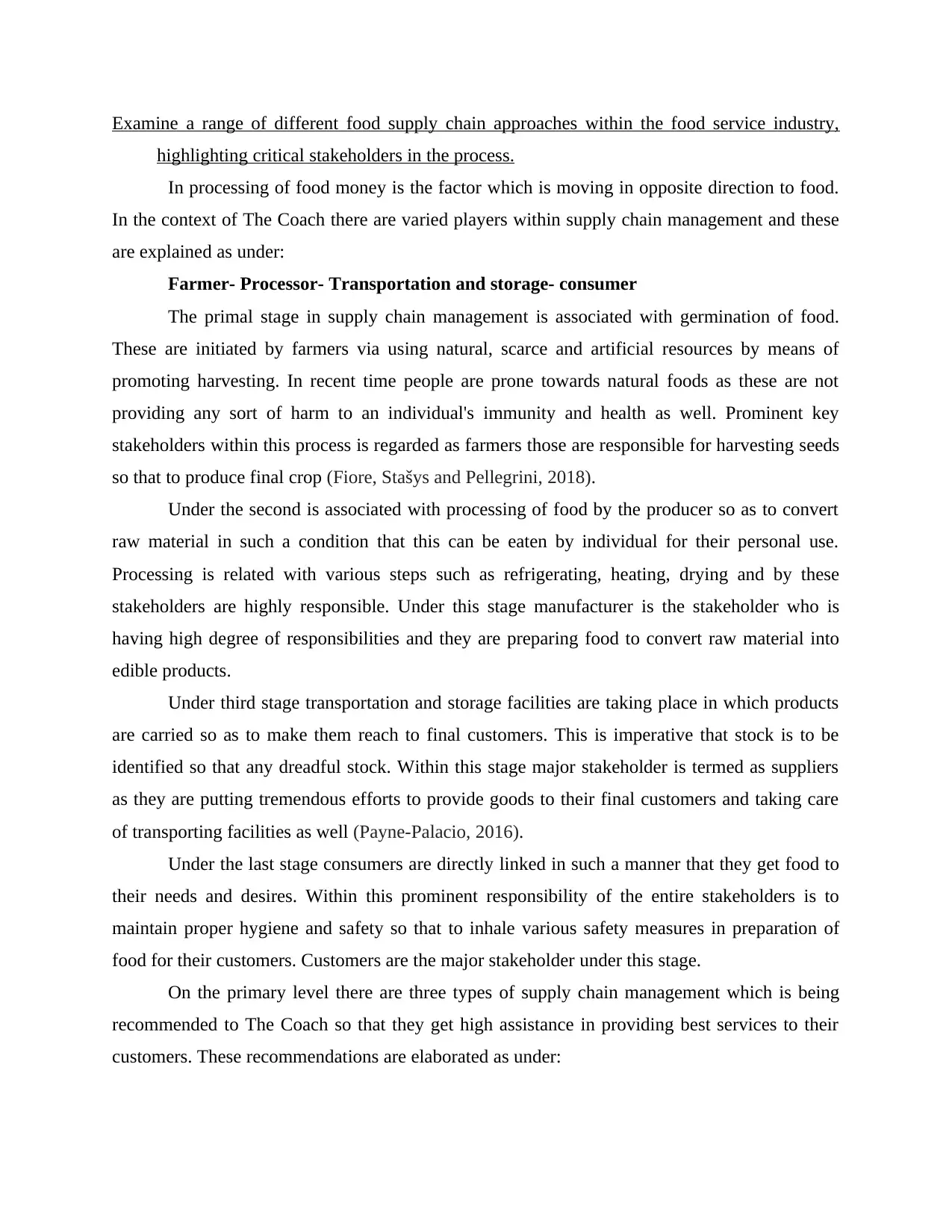
Examine a range of different food supply chain approaches within the food service industry,
highlighting critical stakeholders in the process.
In processing of food money is the factor which is moving in opposite direction to food.
In the context of The Coach there are varied players within supply chain management and these
are explained as under:
Farmer- Processor- Transportation and storage- consumer
The primal stage in supply chain management is associated with germination of food.
These are initiated by farmers via using natural, scarce and artificial resources by means of
promoting harvesting. In recent time people are prone towards natural foods as these are not
providing any sort of harm to an individual's immunity and health as well. Prominent key
stakeholders within this process is regarded as farmers those are responsible for harvesting seeds
so that to produce final crop (Fiore, Stašys and Pellegrini, 2018).
Under the second is associated with processing of food by the producer so as to convert
raw material in such a condition that this can be eaten by individual for their personal use.
Processing is related with various steps such as refrigerating, heating, drying and by these
stakeholders are highly responsible. Under this stage manufacturer is the stakeholder who is
having high degree of responsibilities and they are preparing food to convert raw material into
edible products.
Under third stage transportation and storage facilities are taking place in which products
are carried so as to make them reach to final customers. This is imperative that stock is to be
identified so that any dreadful stock. Within this stage major stakeholder is termed as suppliers
as they are putting tremendous efforts to provide goods to their final customers and taking care
of transporting facilities as well (Payne-Palacio, 2016).
Under the last stage consumers are directly linked in such a manner that they get food to
their needs and desires. Within this prominent responsibility of the entire stakeholders is to
maintain proper hygiene and safety so that to inhale various safety measures in preparation of
food for their customers. Customers are the major stakeholder under this stage.
On the primary level there are three types of supply chain management which is being
recommended to The Coach so that they get high assistance in providing best services to their
customers. These recommendations are elaborated as under:
highlighting critical stakeholders in the process.
In processing of food money is the factor which is moving in opposite direction to food.
In the context of The Coach there are varied players within supply chain management and these
are explained as under:
Farmer- Processor- Transportation and storage- consumer
The primal stage in supply chain management is associated with germination of food.
These are initiated by farmers via using natural, scarce and artificial resources by means of
promoting harvesting. In recent time people are prone towards natural foods as these are not
providing any sort of harm to an individual's immunity and health as well. Prominent key
stakeholders within this process is regarded as farmers those are responsible for harvesting seeds
so that to produce final crop (Fiore, Stašys and Pellegrini, 2018).
Under the second is associated with processing of food by the producer so as to convert
raw material in such a condition that this can be eaten by individual for their personal use.
Processing is related with various steps such as refrigerating, heating, drying and by these
stakeholders are highly responsible. Under this stage manufacturer is the stakeholder who is
having high degree of responsibilities and they are preparing food to convert raw material into
edible products.
Under third stage transportation and storage facilities are taking place in which products
are carried so as to make them reach to final customers. This is imperative that stock is to be
identified so that any dreadful stock. Within this stage major stakeholder is termed as suppliers
as they are putting tremendous efforts to provide goods to their final customers and taking care
of transporting facilities as well (Payne-Palacio, 2016).
Under the last stage consumers are directly linked in such a manner that they get food to
their needs and desires. Within this prominent responsibility of the entire stakeholders is to
maintain proper hygiene and safety so that to inhale various safety measures in preparation of
food for their customers. Customers are the major stakeholder under this stage.
On the primary level there are three types of supply chain management which is being
recommended to The Coach so that they get high assistance in providing best services to their
customers. These recommendations are elaborated as under:
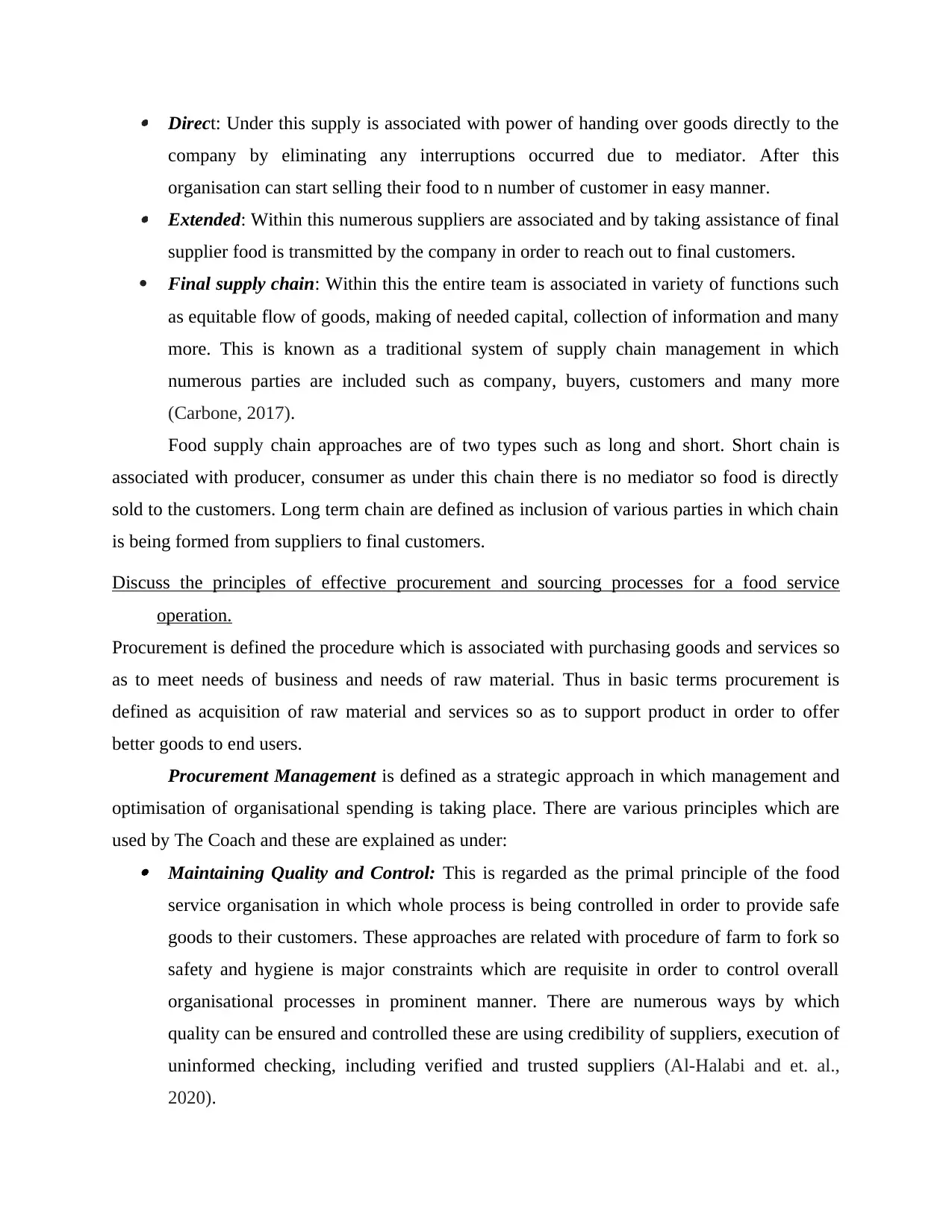
Direct: Under this supply is associated with power of handing over goods directly to the
company by eliminating any interruptions occurred due to mediator. After this
organisation can start selling their food to n number of customer in easy manner. Extended: Within this numerous suppliers are associated and by taking assistance of final
supplier food is transmitted by the company in order to reach out to final customers.
Final supply chain: Within this the entire team is associated in variety of functions such
as equitable flow of goods, making of needed capital, collection of information and many
more. This is known as a traditional system of supply chain management in which
numerous parties are included such as company, buyers, customers and many more
(Carbone, 2017).
Food supply chain approaches are of two types such as long and short. Short chain is
associated with producer, consumer as under this chain there is no mediator so food is directly
sold to the customers. Long term chain are defined as inclusion of various parties in which chain
is being formed from suppliers to final customers.
Discuss the principles of effective procurement and sourcing processes for a food service
operation.
Procurement is defined the procedure which is associated with purchasing goods and services so
as to meet needs of business and needs of raw material. Thus in basic terms procurement is
defined as acquisition of raw material and services so as to support product in order to offer
better goods to end users.
Procurement Management is defined as a strategic approach in which management and
optimisation of organisational spending is taking place. There are various principles which are
used by The Coach and these are explained as under: Maintaining Quality and Control: This is regarded as the primal principle of the food
service organisation in which whole process is being controlled in order to provide safe
goods to their customers. These approaches are related with procedure of farm to fork so
safety and hygiene is major constraints which are requisite in order to control overall
organisational processes in prominent manner. There are numerous ways by which
quality can be ensured and controlled these are using credibility of suppliers, execution of
uninformed checking, including verified and trusted suppliers (Al-Halabi and et. al.,
2020).
company by eliminating any interruptions occurred due to mediator. After this
organisation can start selling their food to n number of customer in easy manner. Extended: Within this numerous suppliers are associated and by taking assistance of final
supplier food is transmitted by the company in order to reach out to final customers.
Final supply chain: Within this the entire team is associated in variety of functions such
as equitable flow of goods, making of needed capital, collection of information and many
more. This is known as a traditional system of supply chain management in which
numerous parties are included such as company, buyers, customers and many more
(Carbone, 2017).
Food supply chain approaches are of two types such as long and short. Short chain is
associated with producer, consumer as under this chain there is no mediator so food is directly
sold to the customers. Long term chain are defined as inclusion of various parties in which chain
is being formed from suppliers to final customers.
Discuss the principles of effective procurement and sourcing processes for a food service
operation.
Procurement is defined the procedure which is associated with purchasing goods and services so
as to meet needs of business and needs of raw material. Thus in basic terms procurement is
defined as acquisition of raw material and services so as to support product in order to offer
better goods to end users.
Procurement Management is defined as a strategic approach in which management and
optimisation of organisational spending is taking place. There are various principles which are
used by The Coach and these are explained as under: Maintaining Quality and Control: This is regarded as the primal principle of the food
service organisation in which whole process is being controlled in order to provide safe
goods to their customers. These approaches are related with procedure of farm to fork so
safety and hygiene is major constraints which are requisite in order to control overall
organisational processes in prominent manner. There are numerous ways by which
quality can be ensured and controlled these are using credibility of suppliers, execution of
uninformed checking, including verified and trusted suppliers (Al-Halabi and et. al.,
2020).
⊘ This is a preview!⊘
Do you want full access?
Subscribe today to unlock all pages.

Trusted by 1+ million students worldwide
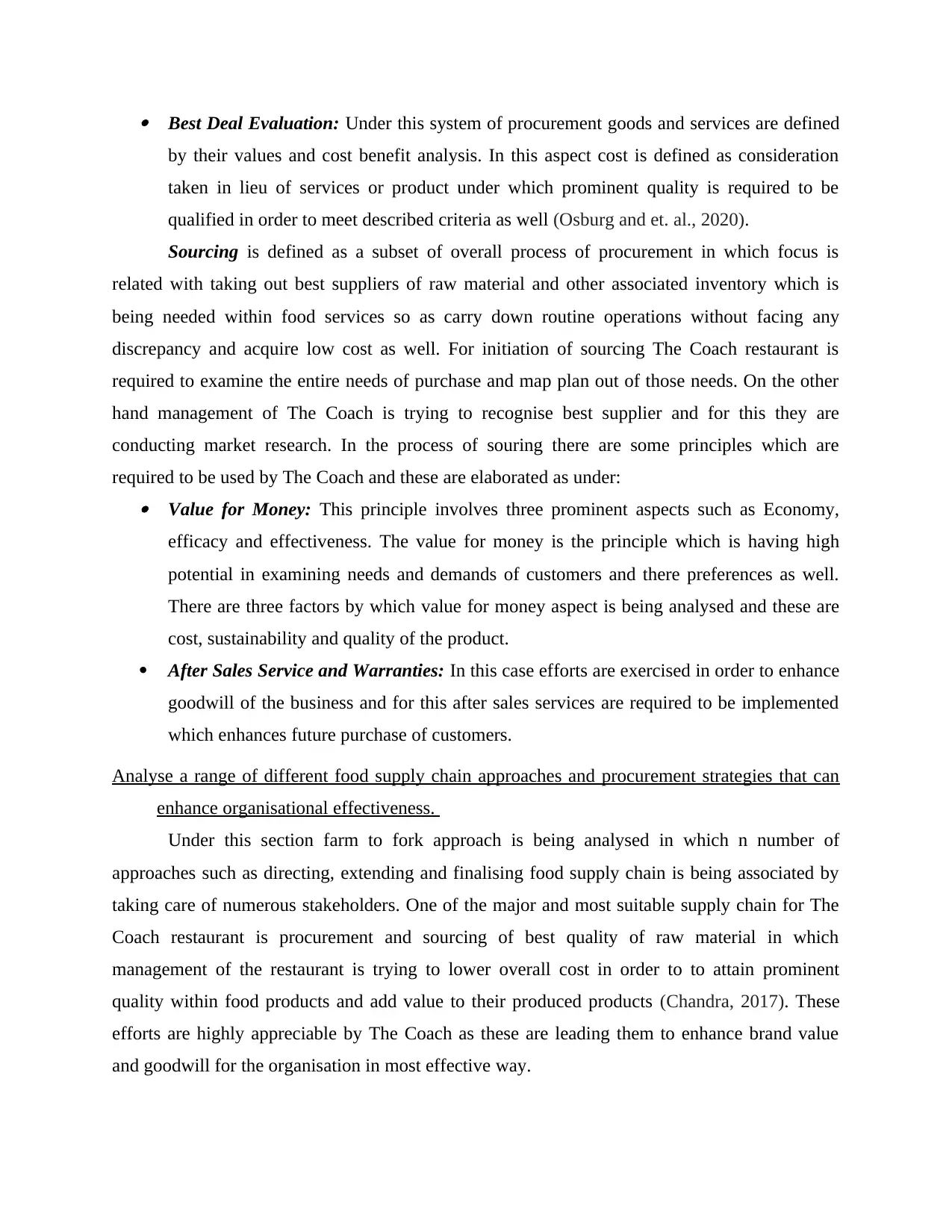
Best Deal Evaluation: Under this system of procurement goods and services are defined
by their values and cost benefit analysis. In this aspect cost is defined as consideration
taken in lieu of services or product under which prominent quality is required to be
qualified in order to meet described criteria as well (Osburg and et. al., 2020).
Sourcing is defined as a subset of overall process of procurement in which focus is
related with taking out best suppliers of raw material and other associated inventory which is
being needed within food services so as carry down routine operations without facing any
discrepancy and acquire low cost as well. For initiation of sourcing The Coach restaurant is
required to examine the entire needs of purchase and map plan out of those needs. On the other
hand management of The Coach is trying to recognise best supplier and for this they are
conducting market research. In the process of souring there are some principles which are
required to be used by The Coach and these are elaborated as under: Value for Money: This principle involves three prominent aspects such as Economy,
efficacy and effectiveness. The value for money is the principle which is having high
potential in examining needs and demands of customers and there preferences as well.
There are three factors by which value for money aspect is being analysed and these are
cost, sustainability and quality of the product.
After Sales Service and Warranties: In this case efforts are exercised in order to enhance
goodwill of the business and for this after sales services are required to be implemented
which enhances future purchase of customers.
Analyse a range of different food supply chain approaches and procurement strategies that can
enhance organisational effectiveness.
Under this section farm to fork approach is being analysed in which n number of
approaches such as directing, extending and finalising food supply chain is being associated by
taking care of numerous stakeholders. One of the major and most suitable supply chain for The
Coach restaurant is procurement and sourcing of best quality of raw material in which
management of the restaurant is trying to lower overall cost in order to to attain prominent
quality within food products and add value to their produced products (Chandra, 2017). These
efforts are highly appreciable by The Coach as these are leading them to enhance brand value
and goodwill for the organisation in most effective way.
by their values and cost benefit analysis. In this aspect cost is defined as consideration
taken in lieu of services or product under which prominent quality is required to be
qualified in order to meet described criteria as well (Osburg and et. al., 2020).
Sourcing is defined as a subset of overall process of procurement in which focus is
related with taking out best suppliers of raw material and other associated inventory which is
being needed within food services so as carry down routine operations without facing any
discrepancy and acquire low cost as well. For initiation of sourcing The Coach restaurant is
required to examine the entire needs of purchase and map plan out of those needs. On the other
hand management of The Coach is trying to recognise best supplier and for this they are
conducting market research. In the process of souring there are some principles which are
required to be used by The Coach and these are elaborated as under: Value for Money: This principle involves three prominent aspects such as Economy,
efficacy and effectiveness. The value for money is the principle which is having high
potential in examining needs and demands of customers and there preferences as well.
There are three factors by which value for money aspect is being analysed and these are
cost, sustainability and quality of the product.
After Sales Service and Warranties: In this case efforts are exercised in order to enhance
goodwill of the business and for this after sales services are required to be implemented
which enhances future purchase of customers.
Analyse a range of different food supply chain approaches and procurement strategies that can
enhance organisational effectiveness.
Under this section farm to fork approach is being analysed in which n number of
approaches such as directing, extending and finalising food supply chain is being associated by
taking care of numerous stakeholders. One of the major and most suitable supply chain for The
Coach restaurant is procurement and sourcing of best quality of raw material in which
management of the restaurant is trying to lower overall cost in order to to attain prominent
quality within food products and add value to their produced products (Chandra, 2017). These
efforts are highly appreciable by The Coach as these are leading them to enhance brand value
and goodwill for the organisation in most effective way.
Paraphrase This Document
Need a fresh take? Get an instant paraphrase of this document with our AI Paraphraser
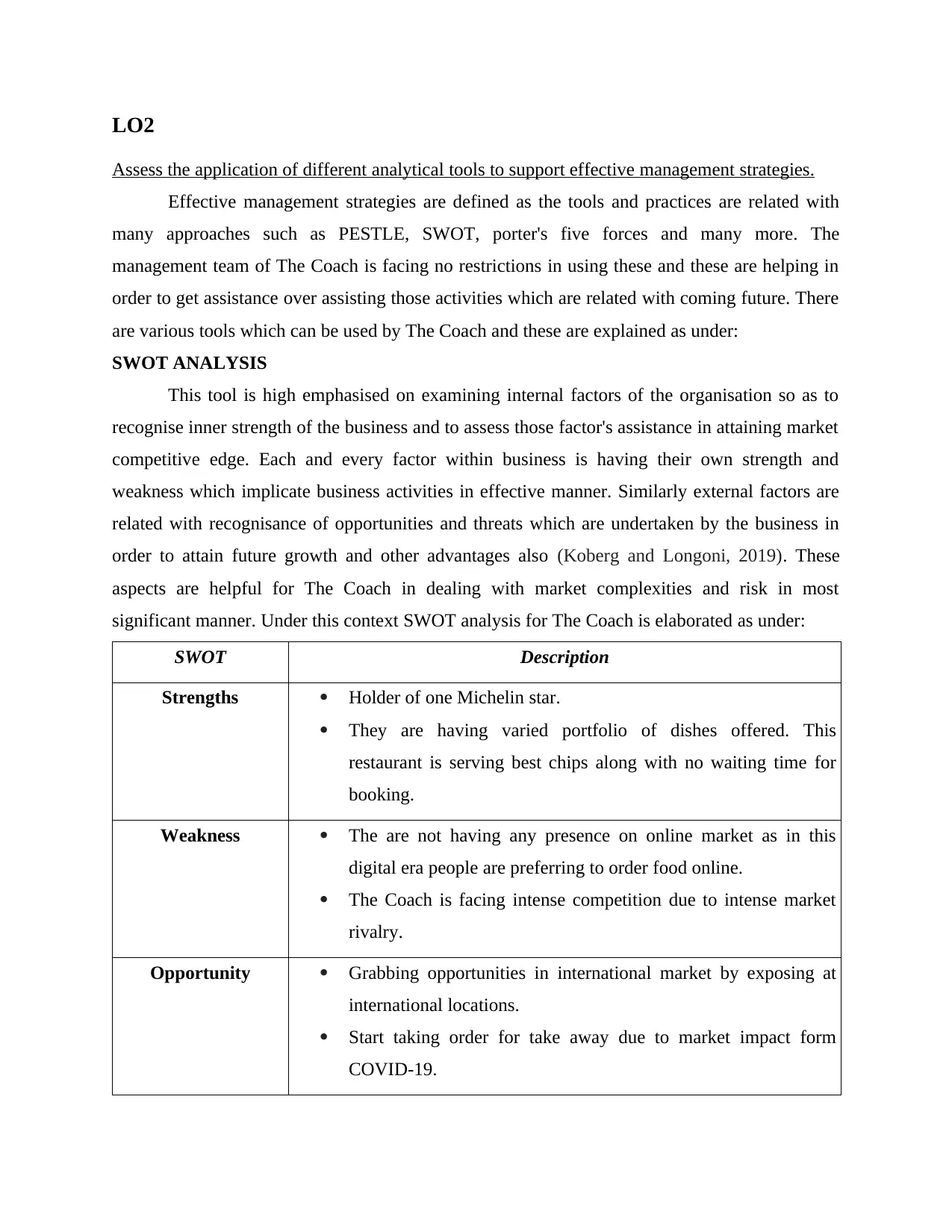
LO2
Assess the application of different analytical tools to support effective management strategies.
Effective management strategies are defined as the tools and practices are related with
many approaches such as PESTLE, SWOT, porter's five forces and many more. The
management team of The Coach is facing no restrictions in using these and these are helping in
order to get assistance over assisting those activities which are related with coming future. There
are various tools which can be used by The Coach and these are explained as under:
SWOT ANALYSIS
This tool is high emphasised on examining internal factors of the organisation so as to
recognise inner strength of the business and to assess those factor's assistance in attaining market
competitive edge. Each and every factor within business is having their own strength and
weakness which implicate business activities in effective manner. Similarly external factors are
related with recognisance of opportunities and threats which are undertaken by the business in
order to attain future growth and other advantages also (Koberg and Longoni, 2019). These
aspects are helpful for The Coach in dealing with market complexities and risk in most
significant manner. Under this context SWOT analysis for The Coach is elaborated as under:
SWOT Description
Strengths Holder of one Michelin star.
They are having varied portfolio of dishes offered. This
restaurant is serving best chips along with no waiting time for
booking.
Weakness The are not having any presence on online market as in this
digital era people are preferring to order food online.
The Coach is facing intense competition due to intense market
rivalry.
Opportunity Grabbing opportunities in international market by exposing at
international locations.
Start taking order for take away due to market impact form
COVID-19.
Assess the application of different analytical tools to support effective management strategies.
Effective management strategies are defined as the tools and practices are related with
many approaches such as PESTLE, SWOT, porter's five forces and many more. The
management team of The Coach is facing no restrictions in using these and these are helping in
order to get assistance over assisting those activities which are related with coming future. There
are various tools which can be used by The Coach and these are explained as under:
SWOT ANALYSIS
This tool is high emphasised on examining internal factors of the organisation so as to
recognise inner strength of the business and to assess those factor's assistance in attaining market
competitive edge. Each and every factor within business is having their own strength and
weakness which implicate business activities in effective manner. Similarly external factors are
related with recognisance of opportunities and threats which are undertaken by the business in
order to attain future growth and other advantages also (Koberg and Longoni, 2019). These
aspects are helpful for The Coach in dealing with market complexities and risk in most
significant manner. Under this context SWOT analysis for The Coach is elaborated as under:
SWOT Description
Strengths Holder of one Michelin star.
They are having varied portfolio of dishes offered. This
restaurant is serving best chips along with no waiting time for
booking.
Weakness The are not having any presence on online market as in this
digital era people are preferring to order food online.
The Coach is facing intense competition due to intense market
rivalry.
Opportunity Grabbing opportunities in international market by exposing at
international locations.
Start taking order for take away due to market impact form
COVID-19.
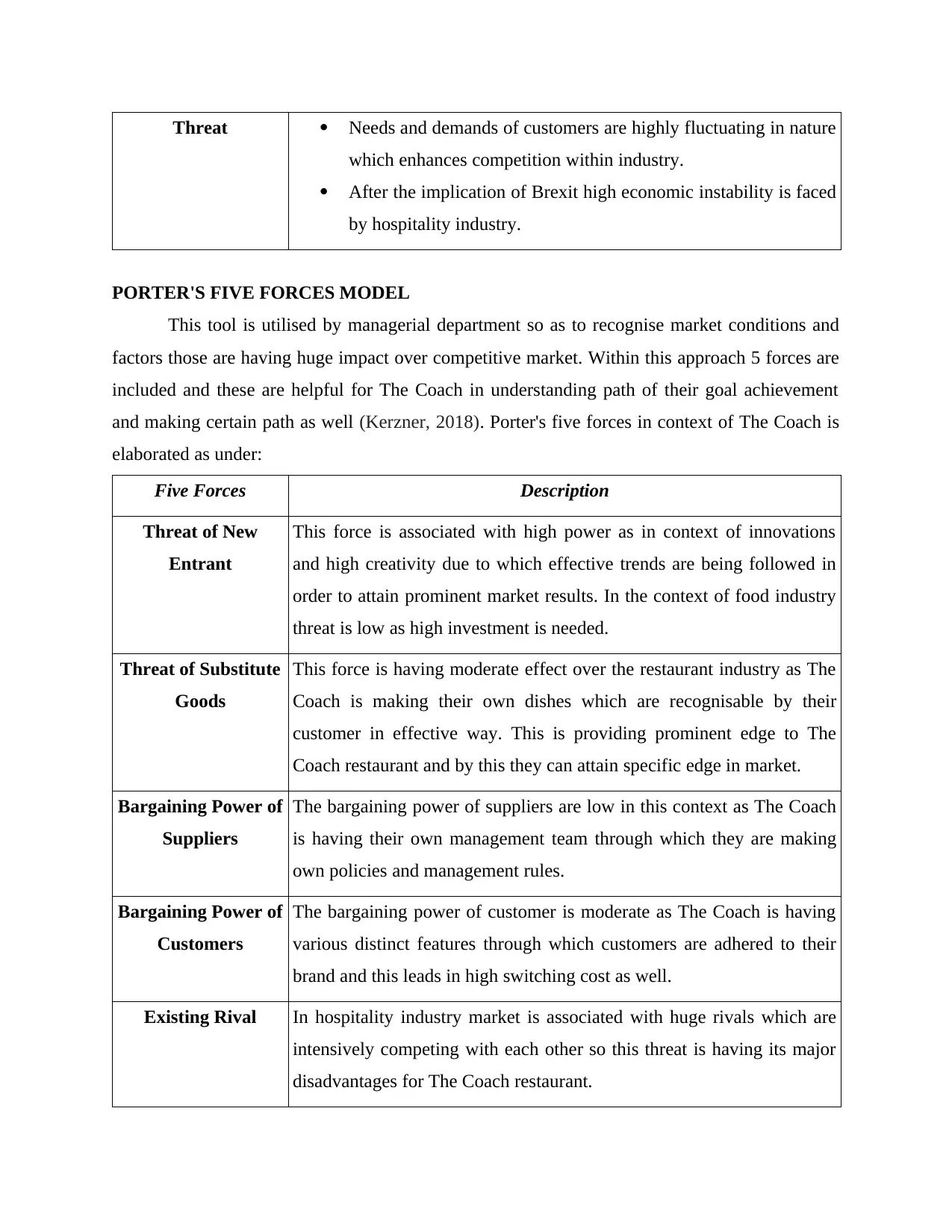
Threat Needs and demands of customers are highly fluctuating in nature
which enhances competition within industry.
After the implication of Brexit high economic instability is faced
by hospitality industry.
PORTER'S FIVE FORCES MODEL
This tool is utilised by managerial department so as to recognise market conditions and
factors those are having huge impact over competitive market. Within this approach 5 forces are
included and these are helpful for The Coach in understanding path of their goal achievement
and making certain path as well (Kerzner, 2018). Porter's five forces in context of The Coach is
elaborated as under:
Five Forces Description
Threat of New
Entrant
This force is associated with high power as in context of innovations
and high creativity due to which effective trends are being followed in
order to attain prominent market results. In the context of food industry
threat is low as high investment is needed.
Threat of Substitute
Goods
This force is having moderate effect over the restaurant industry as The
Coach is making their own dishes which are recognisable by their
customer in effective way. This is providing prominent edge to The
Coach restaurant and by this they can attain specific edge in market.
Bargaining Power of
Suppliers
The bargaining power of suppliers are low in this context as The Coach
is having their own management team through which they are making
own policies and management rules.
Bargaining Power of
Customers
The bargaining power of customer is moderate as The Coach is having
various distinct features through which customers are adhered to their
brand and this leads in high switching cost as well.
Existing Rival In hospitality industry market is associated with huge rivals which are
intensively competing with each other so this threat is having its major
disadvantages for The Coach restaurant.
which enhances competition within industry.
After the implication of Brexit high economic instability is faced
by hospitality industry.
PORTER'S FIVE FORCES MODEL
This tool is utilised by managerial department so as to recognise market conditions and
factors those are having huge impact over competitive market. Within this approach 5 forces are
included and these are helpful for The Coach in understanding path of their goal achievement
and making certain path as well (Kerzner, 2018). Porter's five forces in context of The Coach is
elaborated as under:
Five Forces Description
Threat of New
Entrant
This force is associated with high power as in context of innovations
and high creativity due to which effective trends are being followed in
order to attain prominent market results. In the context of food industry
threat is low as high investment is needed.
Threat of Substitute
Goods
This force is having moderate effect over the restaurant industry as The
Coach is making their own dishes which are recognisable by their
customer in effective way. This is providing prominent edge to The
Coach restaurant and by this they can attain specific edge in market.
Bargaining Power of
Suppliers
The bargaining power of suppliers are low in this context as The Coach
is having their own management team through which they are making
own policies and management rules.
Bargaining Power of
Customers
The bargaining power of customer is moderate as The Coach is having
various distinct features through which customers are adhered to their
brand and this leads in high switching cost as well.
Existing Rival In hospitality industry market is associated with huge rivals which are
intensively competing with each other so this threat is having its major
disadvantages for The Coach restaurant.
⊘ This is a preview!⊘
Do you want full access?
Subscribe today to unlock all pages.

Trusted by 1+ million students worldwide
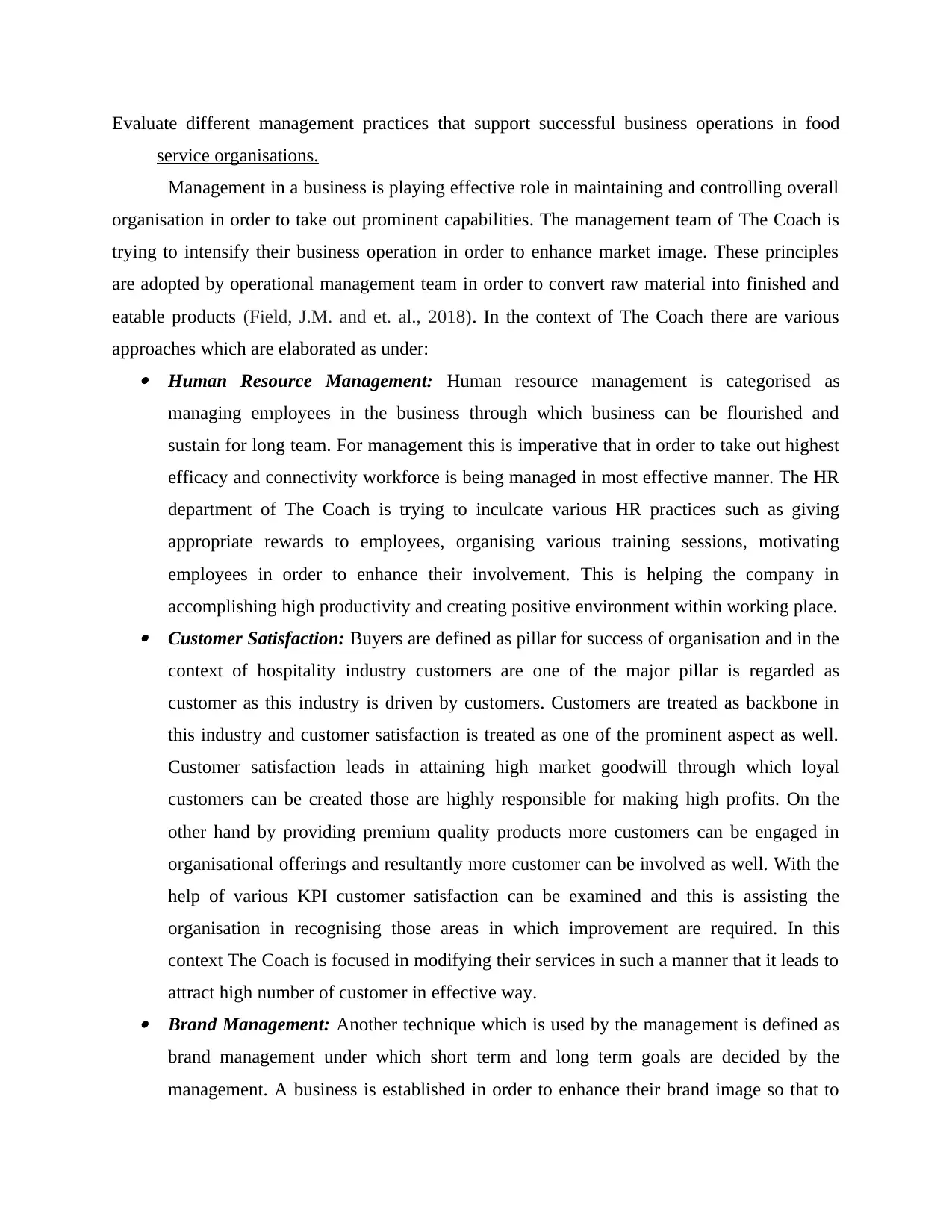
Evaluate different management practices that support successful business operations in food
service organisations.
Management in a business is playing effective role in maintaining and controlling overall
organisation in order to take out prominent capabilities. The management team of The Coach is
trying to intensify their business operation in order to enhance market image. These principles
are adopted by operational management team in order to convert raw material into finished and
eatable products (Field, J.M. and et. al., 2018). In the context of The Coach there are various
approaches which are elaborated as under: Human Resource Management: Human resource management is categorised as
managing employees in the business through which business can be flourished and
sustain for long team. For management this is imperative that in order to take out highest
efficacy and connectivity workforce is being managed in most effective manner. The HR
department of The Coach is trying to inculcate various HR practices such as giving
appropriate rewards to employees, organising various training sessions, motivating
employees in order to enhance their involvement. This is helping the company in
accomplishing high productivity and creating positive environment within working place. Customer Satisfaction: Buyers are defined as pillar for success of organisation and in the
context of hospitality industry customers are one of the major pillar is regarded as
customer as this industry is driven by customers. Customers are treated as backbone in
this industry and customer satisfaction is treated as one of the prominent aspect as well.
Customer satisfaction leads in attaining high market goodwill through which loyal
customers can be created those are highly responsible for making high profits. On the
other hand by providing premium quality products more customers can be engaged in
organisational offerings and resultantly more customer can be involved as well. With the
help of various KPI customer satisfaction can be examined and this is assisting the
organisation in recognising those areas in which improvement are required. In this
context The Coach is focused in modifying their services in such a manner that it leads to
attract high number of customer in effective way. Brand Management: Another technique which is used by the management is defined as
brand management under which short term and long term goals are decided by the
management. A business is established in order to enhance their brand image so that to
service organisations.
Management in a business is playing effective role in maintaining and controlling overall
organisation in order to take out prominent capabilities. The management team of The Coach is
trying to intensify their business operation in order to enhance market image. These principles
are adopted by operational management team in order to convert raw material into finished and
eatable products (Field, J.M. and et. al., 2018). In the context of The Coach there are various
approaches which are elaborated as under: Human Resource Management: Human resource management is categorised as
managing employees in the business through which business can be flourished and
sustain for long team. For management this is imperative that in order to take out highest
efficacy and connectivity workforce is being managed in most effective manner. The HR
department of The Coach is trying to inculcate various HR practices such as giving
appropriate rewards to employees, organising various training sessions, motivating
employees in order to enhance their involvement. This is helping the company in
accomplishing high productivity and creating positive environment within working place. Customer Satisfaction: Buyers are defined as pillar for success of organisation and in the
context of hospitality industry customers are one of the major pillar is regarded as
customer as this industry is driven by customers. Customers are treated as backbone in
this industry and customer satisfaction is treated as one of the prominent aspect as well.
Customer satisfaction leads in attaining high market goodwill through which loyal
customers can be created those are highly responsible for making high profits. On the
other hand by providing premium quality products more customers can be engaged in
organisational offerings and resultantly more customer can be involved as well. With the
help of various KPI customer satisfaction can be examined and this is assisting the
organisation in recognising those areas in which improvement are required. In this
context The Coach is focused in modifying their services in such a manner that it leads to
attract high number of customer in effective way. Brand Management: Another technique which is used by the management is defined as
brand management under which short term and long term goals are decided by the
management. A business is established in order to enhance their brand image so that to
Paraphrase This Document
Need a fresh take? Get an instant paraphrase of this document with our AI Paraphraser
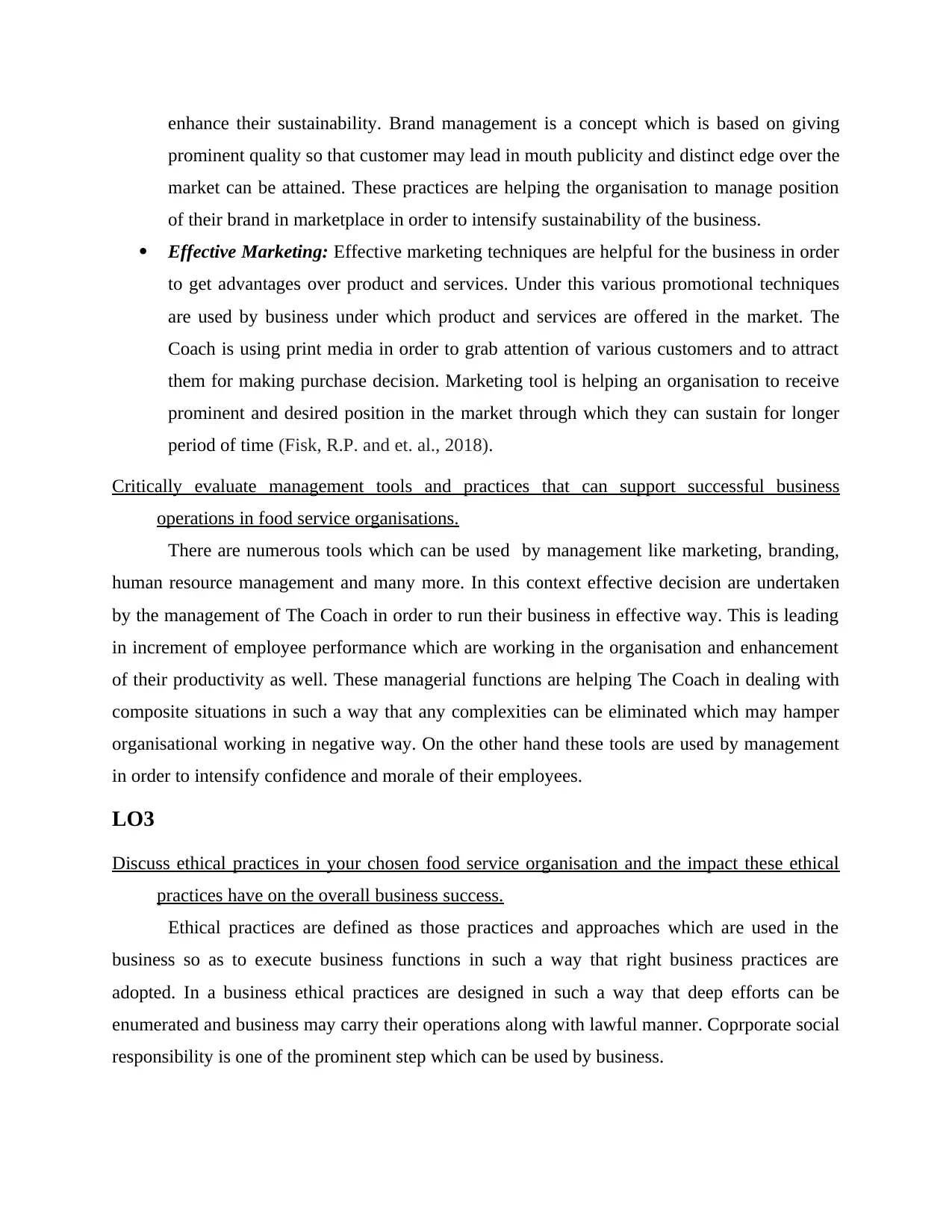
enhance their sustainability. Brand management is a concept which is based on giving
prominent quality so that customer may lead in mouth publicity and distinct edge over the
market can be attained. These practices are helping the organisation to manage position
of their brand in marketplace in order to intensify sustainability of the business.
Effective Marketing: Effective marketing techniques are helpful for the business in order
to get advantages over product and services. Under this various promotional techniques
are used by business under which product and services are offered in the market. The
Coach is using print media in order to grab attention of various customers and to attract
them for making purchase decision. Marketing tool is helping an organisation to receive
prominent and desired position in the market through which they can sustain for longer
period of time (Fisk, R.P. and et. al., 2018).
Critically evaluate management tools and practices that can support successful business
operations in food service organisations.
There are numerous tools which can be used by management like marketing, branding,
human resource management and many more. In this context effective decision are undertaken
by the management of The Coach in order to run their business in effective way. This is leading
in increment of employee performance which are working in the organisation and enhancement
of their productivity as well. These managerial functions are helping The Coach in dealing with
composite situations in such a way that any complexities can be eliminated which may hamper
organisational working in negative way. On the other hand these tools are used by management
in order to intensify confidence and morale of their employees.
LO3
Discuss ethical practices in your chosen food service organisation and the impact these ethical
practices have on the overall business success.
Ethical practices are defined as those practices and approaches which are used in the
business so as to execute business functions in such a way that right business practices are
adopted. In a business ethical practices are designed in such a way that deep efforts can be
enumerated and business may carry their operations along with lawful manner. Coprporate social
responsibility is one of the prominent step which can be used by business.
prominent quality so that customer may lead in mouth publicity and distinct edge over the
market can be attained. These practices are helping the organisation to manage position
of their brand in marketplace in order to intensify sustainability of the business.
Effective Marketing: Effective marketing techniques are helpful for the business in order
to get advantages over product and services. Under this various promotional techniques
are used by business under which product and services are offered in the market. The
Coach is using print media in order to grab attention of various customers and to attract
them for making purchase decision. Marketing tool is helping an organisation to receive
prominent and desired position in the market through which they can sustain for longer
period of time (Fisk, R.P. and et. al., 2018).
Critically evaluate management tools and practices that can support successful business
operations in food service organisations.
There are numerous tools which can be used by management like marketing, branding,
human resource management and many more. In this context effective decision are undertaken
by the management of The Coach in order to run their business in effective way. This is leading
in increment of employee performance which are working in the organisation and enhancement
of their productivity as well. These managerial functions are helping The Coach in dealing with
composite situations in such a way that any complexities can be eliminated which may hamper
organisational working in negative way. On the other hand these tools are used by management
in order to intensify confidence and morale of their employees.
LO3
Discuss ethical practices in your chosen food service organisation and the impact these ethical
practices have on the overall business success.
Ethical practices are defined as those practices and approaches which are used in the
business so as to execute business functions in such a way that right business practices are
adopted. In a business ethical practices are designed in such a way that deep efforts can be
enumerated and business may carry their operations along with lawful manner. Coprporate social
responsibility is one of the prominent step which can be used by business.
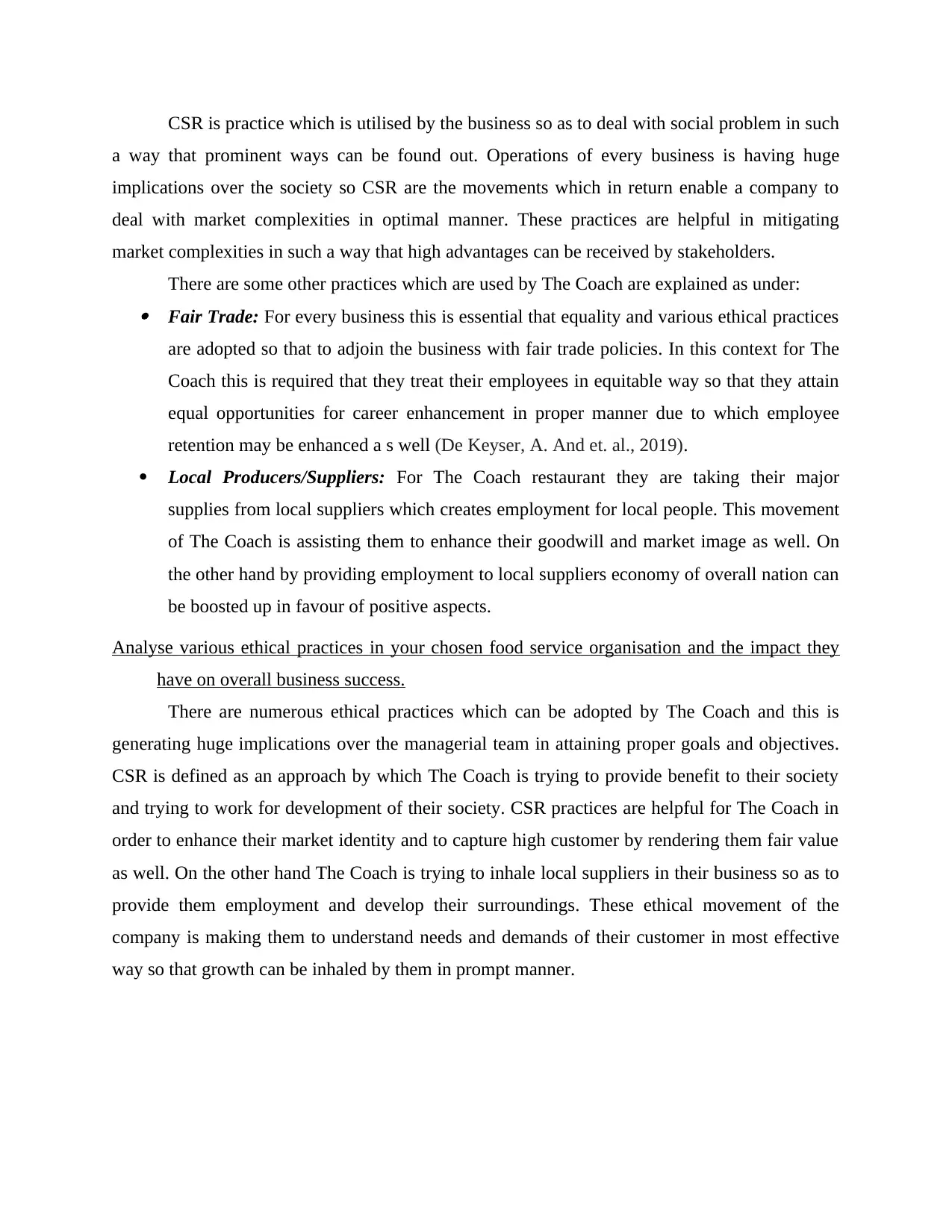
CSR is practice which is utilised by the business so as to deal with social problem in such
a way that prominent ways can be found out. Operations of every business is having huge
implications over the society so CSR are the movements which in return enable a company to
deal with market complexities in optimal manner. These practices are helpful in mitigating
market complexities in such a way that high advantages can be received by stakeholders.
There are some other practices which are used by The Coach are explained as under: Fair Trade: For every business this is essential that equality and various ethical practices
are adopted so that to adjoin the business with fair trade policies. In this context for The
Coach this is required that they treat their employees in equitable way so that they attain
equal opportunities for career enhancement in proper manner due to which employee
retention may be enhanced a s well (De Keyser, A. And et. al., 2019).
Local Producers/Suppliers: For The Coach restaurant they are taking their major
supplies from local suppliers which creates employment for local people. This movement
of The Coach is assisting them to enhance their goodwill and market image as well. On
the other hand by providing employment to local suppliers economy of overall nation can
be boosted up in favour of positive aspects.
Analyse various ethical practices in your chosen food service organisation and the impact they
have on overall business success.
There are numerous ethical practices which can be adopted by The Coach and this is
generating huge implications over the managerial team in attaining proper goals and objectives.
CSR is defined as an approach by which The Coach is trying to provide benefit to their society
and trying to work for development of their society. CSR practices are helpful for The Coach in
order to enhance their market identity and to capture high customer by rendering them fair value
as well. On the other hand The Coach is trying to inhale local suppliers in their business so as to
provide them employment and develop their surroundings. These ethical movement of the
company is making them to understand needs and demands of their customer in most effective
way so that growth can be inhaled by them in prompt manner.
a way that prominent ways can be found out. Operations of every business is having huge
implications over the society so CSR are the movements which in return enable a company to
deal with market complexities in optimal manner. These practices are helpful in mitigating
market complexities in such a way that high advantages can be received by stakeholders.
There are some other practices which are used by The Coach are explained as under: Fair Trade: For every business this is essential that equality and various ethical practices
are adopted so that to adjoin the business with fair trade policies. In this context for The
Coach this is required that they treat their employees in equitable way so that they attain
equal opportunities for career enhancement in proper manner due to which employee
retention may be enhanced a s well (De Keyser, A. And et. al., 2019).
Local Producers/Suppliers: For The Coach restaurant they are taking their major
supplies from local suppliers which creates employment for local people. This movement
of The Coach is assisting them to enhance their goodwill and market image as well. On
the other hand by providing employment to local suppliers economy of overall nation can
be boosted up in favour of positive aspects.
Analyse various ethical practices in your chosen food service organisation and the impact they
have on overall business success.
There are numerous ethical practices which can be adopted by The Coach and this is
generating huge implications over the managerial team in attaining proper goals and objectives.
CSR is defined as an approach by which The Coach is trying to provide benefit to their society
and trying to work for development of their society. CSR practices are helpful for The Coach in
order to enhance their market identity and to capture high customer by rendering them fair value
as well. On the other hand The Coach is trying to inhale local suppliers in their business so as to
provide them employment and develop their surroundings. These ethical movement of the
company is making them to understand needs and demands of their customer in most effective
way so that growth can be inhaled by them in prompt manner.
⊘ This is a preview!⊘
Do you want full access?
Subscribe today to unlock all pages.

Trusted by 1+ million students worldwide
1 out of 16
Related Documents
Your All-in-One AI-Powered Toolkit for Academic Success.
+13062052269
info@desklib.com
Available 24*7 on WhatsApp / Email
![[object Object]](/_next/static/media/star-bottom.7253800d.svg)
Unlock your academic potential
Copyright © 2020–2025 A2Z Services. All Rights Reserved. Developed and managed by ZUCOL.




